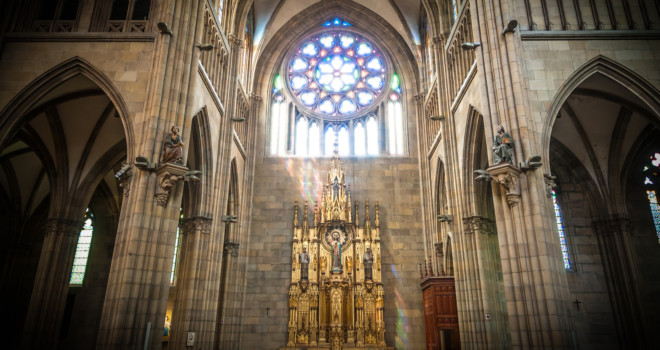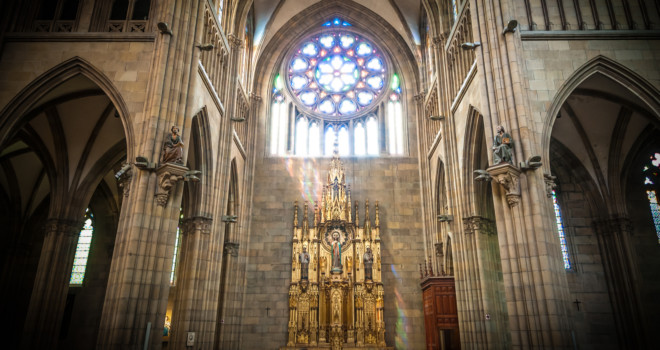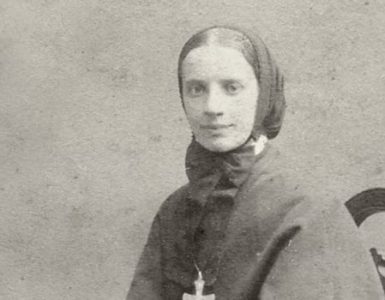One of the most admirable characteristics found in the life of Jesus Christ, our Master and our Model, is silence. All the mysteries of His mortal life and the ineffable mystery of His Eucharistic life have this mark: the divine seal of silence.
Holy Church tells us that Jesus came to this world in the midst of universal silence: “While gentle silence enveloped all things, and night in its swift course was now half gone, Thy all-powerful Word leaped from Heaven, from the royal throne.” The first thirty years of the life of Jesus were wrapped in an impressive silence. Afterward came the three years of His public life. This was the time for speaking, the time for communicating with men. Yet even this period contains marvels of silence. Silence is something so characteristic of Christ’s Passion that the prophet commented on it, saying, “Like a lamb that is led to the slaughter, and like a sheep that before its shearers is dumb, so He opened not His mouth.”
In His Eucharistic life, does not that unfathomable silence enveloping the Eucharist impress us profoundly and communicate itself to us when we approach?
Silence is not classified as a virtue, but it is the atmosphere in which virtues develop. At the same time, it is a sign of their maturity. Thus, just as we know that when the golden spikes of wheat appear in the field, the grain is ripe, so also, when a virtue is tinted with silence, we perceive that it is reaching maturity.
Let us make some reflections upon the silence of Jesus and try to reproduce it in our heart so that we can imitate it in our lives.
Learn to practice interior silence
Let us consider the silence of Jesus during His hidden life, that is, the first thirty years of His life. This silence is truly inexplicable. If there had ever been a man with the right to speak, with all the gifts for attracting attention, with all the means to create a stir, that man was Jesus, because He was the Eternal Word of the Father, uncreated Wisdom, the Master whom men had awaited for so many centuries. Certainly, if there is any single event in history that merits a stir in its behalf, it is the coming of Christ to live among us. But instead, a hush shrouds His first thirty years.
The Gospel, speaking to us of these years, is restrained, almost mute. Many times we would like to know a little more of the mysteries of the infancy of Jesus to nourish our piety. But the Gospel makes only an occasional reference to the episodes of His first years. A few pages refer to the hidden life of our Lord, and each incident mentioned, like murmurs heard in quiet fields, emphasizes and accentuates the silence rather than destroys it: the adoration of the Magi, the flight into Egypt, the going up to the Temple — three events that do not disturb the silence of the hidden life, but make it more evident.
We feel this silence in a special manner in the house of Nazareth. It is the “house of silence”; we cannot conceive of it in any other way. Its very mention enshrines our souls in silence. When we meditate on the mysteries enacted there, we feel that all who dwelled there were divinely silent.
St. Joseph: not a single word of his has been preserved for us in the Gospel, and we cannot imagine him except as enraptured in silent contemplation of those mysteries taking place around him.
The most holy Virgin was silent too, with that silence of wonder and of love which the presence of Jesus produced in her; a silence augmented by His holy illumination and by the mysteries that she witnessed and in which she participated. The Gospel presents one mysterious statement that allows us to catch a glimmering view, as it were, of the abyss of silence and contemplation in the heart of the most holy Virgin. Having narrated those mysteries, the Gospel adds: “His mother kept all these things in her heart.”19She did not discuss them with St. Joseph, but she preserved them and meditated upon them within her own soul.
And Jesus, especially working in St. Joseph’s shop, must have led a silent life with His soul and heart absorbed in the heavenly Father, His soul and His Heart united in prevision to ours, dreaming dreams of love and of pain, thinking about the glory He would give to His Father and the good He would do for souls. His spirit was absorbed in the mysteries of the kingdom of Heaven. As I see it, this silence is the silence of contemplation, the silence of the interior life.
Silence & Concentration
Silence, even naturally speaking, invites us to concentrate within ourselves and to think about serious, profound things. For example, when we are in the forest, upon the ocean, or in the desert, we experience the necessity of concentrating, of recollecting ourselves. Such is our psychological structure that noise forces us outside of ourselves, distracting us and scattering our powers; it forces our spirit to go skipping around through external things. But when silence prevails, we concentrate again; once more we live within.
In accordance with this law of our psychology, we need to live within in order to live with God, because we always find God in the interior of our soul. It is natural that exterior silence is not only an invitation to an interior life, but also a necessary condition for that life of intimate communication with God. The atmosphere of the interior life, of the contemplative life, is silence; hence, the masters of the spiritual life recommend it so highly. Therefore, it is one of the most fundamental observances of the religious life.
In order to live the contemplative life, in order to live the religious life in any of its forms, and even for all true interior life, exterior silence is indispensable. To realize its importance in living above and not below, in living a life of intimacy and union with God, let us not lose sight of the fact that silence should not be treated as a mere disciplinary measure or as a means of order such as is found in a school or in a class, but as a necessary condition for living within and not living without.
✠
Editor’s note: This article is adapted from a chapter in Archbishop Martinez’s When God is Silent: Finding Spiritual Peace Amid the Storms of Life, available from Sophia Institute Press.
We also recommend Archbishop Martinez’s True Devotion to the Holy Spirit.













